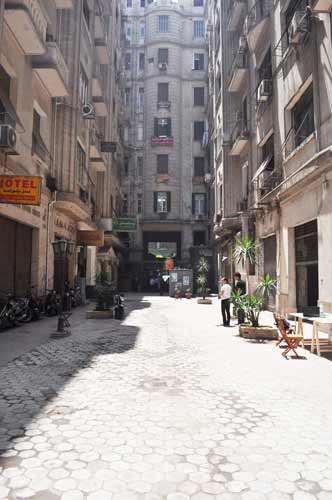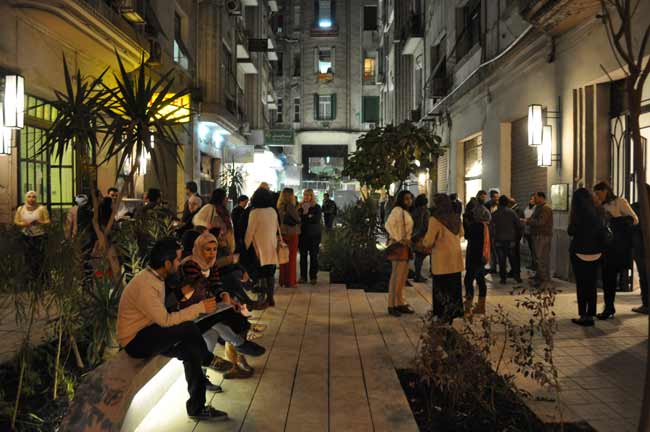http://archrecord.construction.com/news/2015/11/151110-Symposium-Deliberates-the-Future-of-Downtown-Cairo.asp
Symposium Deliberates the Future of Downtown Cairo
As order finally returns to the Egyptian capital, will gentrification set in?
November 10, 2015
Image courtesy CLUSTER
The built and open spaces surrounding Tahrir Square—the public plaza
and staging ground of political demonstrations during the 2011 Egyptian
revolution—have undergone a transformation this year: Beaux-arts facades
received a fresh coat of paint, a 1,700-space underground parking
garage was finally completed, and the square was topped off with a
65-foot-tall flagpole. An International Style hotel known as the Nile
Hilton has been reborn as a new Ritz Carlton, and the Stalinist
structure which housed former president Hosni Mubarak’s National
Democratic Party is now a pile of rubble that, when hauled away, will
become a riverside park sloping from the Egyptian Museum.
These cosmetic improvements are emblematic of the desire of Egyptian authorities to distance themselves from the neglect associated with Mubarak’s regime. The state holds title to the square, the museum, and the Ritz Carlton, but ownership of the estimated 228 pre-1945 buildings that line the streets and squares between Tahrir and the medieval Islamic City is significantly more diversified.
But as order
returns –a process visible in the installation of traffic signals and a
campaign against street vendors who filled the vacuum left by protestors
–long-term residents, a newly-arrived creative class, and private
developers are wrestling over the future of downtown Cairo.
An international symposium convened last weekend by architect and urban planner Omar Nagati and Beth Stryker, co-founder of the Cairo Lab for Urban Studies (CLUSTER), in partnership with the American University in Cairo (AUC) opened a window onto contested visions for the city.
“There are changes around governing practices in public space, including stronger enforcement of laws, in addition to more permits and approvals necessary for public activities. There are also new laws limiting and restricting art and culture organizations,” said Nagati.
The "Re: Framing Downtown" symposium took place at the AUC’s Tahrir Square campus in the heart of Cairo. Several years ago, the institution itself moved most of its degree programs to a suburban facility nearly 22 miles away, purposefully closer to the new gated communities which are home to much of its wealthy undergraduate student body.
During her welcoming address, AUC president Lisa Anderson acknowledged the relocation had adverse impacts for the downtown community while pointing out that some old campus buildings have been repurposed for continuing education programs and a start-up technology hub, demonstrating an ongoing interest in the area.
At times, the symposium took on aspects of a public hearing, with advisors to the city’s governor, Ministry of Culture officials, and managers from the state-owned Misr [Egypt] Real Estate Assets (MREA) revealing and defending plans to neighborhood stakeholders who rarely enjoy access to decision makers in Egypt’s centralized bureaucracy.
MREA owns more than one hundred properties in the area and cites decades-old tenancy and rent control laws as the key barrier to maintenance of historic buildings. MREA has received some public money from The National Organization for Urban Harmony mainly to repair the facades of buildings such as those facing Tahrir Square.
“What I would say to MREA is ‘don’t start fixing your buildings and taking them one way or another until you sit with all the stakeholders and come up with a vision,’” said Karim Shafei, Chairman of Al Ismaelia for Real Estate Investment.
Al Ismaelia has acquired a portfolio of more than twenty historic downtown buildings including the Art Deco Cinema Radio, where Egyptian satirist Bassem Yousef hosted his Jon Stewart-esque late-night talk show, and the Kodak Building, site of a public/private passageway developed last year by Nagati and Stryker of CLUSTER.
While Egypt is conducting its first parliamentary elections since President Abel Fatah El Sisi’s ascension to power, local governance is still entirely in the hands of officials appointed by the executive branch.
“The top-down model, doesn’t work,” said Shafei. “To set a vision and work on creating the public space we need to create an NGO or a Board of Trustees that will overlook Downtown from both an architectural and urban planning point of view, as well as to encourage investments.”
Slide Show |
|
Image courtesy CLUSTER
|
These cosmetic improvements are emblematic of the desire of Egyptian authorities to distance themselves from the neglect associated with Mubarak’s regime. The state holds title to the square, the museum, and the Ritz Carlton, but ownership of the estimated 228 pre-1945 buildings that line the streets and squares between Tahrir and the medieval Islamic City is significantly more diversified.
An international symposium convened last weekend by architect and urban planner Omar Nagati and Beth Stryker, co-founder of the Cairo Lab for Urban Studies (CLUSTER), in partnership with the American University in Cairo (AUC) opened a window onto contested visions for the city.
“There are changes around governing practices in public space, including stronger enforcement of laws, in addition to more permits and approvals necessary for public activities. There are also new laws limiting and restricting art and culture organizations,” said Nagati.
The "Re: Framing Downtown" symposium took place at the AUC’s Tahrir Square campus in the heart of Cairo. Several years ago, the institution itself moved most of its degree programs to a suburban facility nearly 22 miles away, purposefully closer to the new gated communities which are home to much of its wealthy undergraduate student body.
During her welcoming address, AUC president Lisa Anderson acknowledged the relocation had adverse impacts for the downtown community while pointing out that some old campus buildings have been repurposed for continuing education programs and a start-up technology hub, demonstrating an ongoing interest in the area.
At times, the symposium took on aspects of a public hearing, with advisors to the city’s governor, Ministry of Culture officials, and managers from the state-owned Misr [Egypt] Real Estate Assets (MREA) revealing and defending plans to neighborhood stakeholders who rarely enjoy access to decision makers in Egypt’s centralized bureaucracy.
MREA owns more than one hundred properties in the area and cites decades-old tenancy and rent control laws as the key barrier to maintenance of historic buildings. MREA has received some public money from The National Organization for Urban Harmony mainly to repair the facades of buildings such as those facing Tahrir Square.
“What I would say to MREA is ‘don’t start fixing your buildings and taking them one way or another until you sit with all the stakeholders and come up with a vision,’” said Karim Shafei, Chairman of Al Ismaelia for Real Estate Investment.
Al Ismaelia has acquired a portfolio of more than twenty historic downtown buildings including the Art Deco Cinema Radio, where Egyptian satirist Bassem Yousef hosted his Jon Stewart-esque late-night talk show, and the Kodak Building, site of a public/private passageway developed last year by Nagati and Stryker of CLUSTER.
While Egypt is conducting its first parliamentary elections since President Abel Fatah El Sisi’s ascension to power, local governance is still entirely in the hands of officials appointed by the executive branch.
“The top-down model, doesn’t work,” said Shafei. “To set a vision and work on creating the public space we need to create an NGO or a Board of Trustees that will overlook Downtown from both an architectural and urban planning point of view, as well as to encourage investments.”


No comments:
Post a Comment